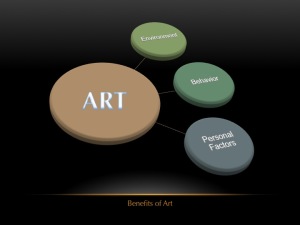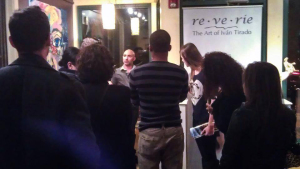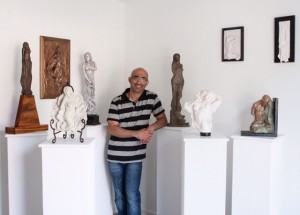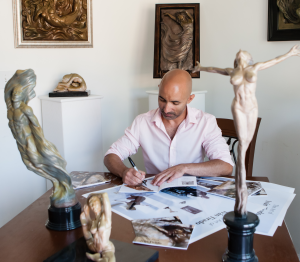Art Changing Lives
A few years ago I was teaching art to children with disabilities. It was my first official teaching job and one of the most rewarding experiences of my life. Back then, the kids called me “Mr. T” (since it was easier than trying to say: “Tirado”). In one of the older kids’ classes I had a student who ran to the bathroom and stayed there every time I can to teach the class. He was friendly outside the classroom, I spent time with his class many times in different activities, and we even had lunch together many times. He never ran away to hide or anything like that. One day during lunch I had to ask: “Why do you hide in the bathroom every time there is art class?”. His answer changed my perception towards teaching and ignited my curiosity to understand self-efficacy beliefs (although I was not familiar with the term back then). He said: “Mr. T, I can’t take that class. I can do nothing of what you teach. I grew up listening to people telling me that I’m stupid. I don’t want to try and then disappoint you too.”
During my doctorate studies I focused my dissertation towards understanding self-efficacy beliefs as a way to predict how people would engage in new learning experiences (you can read about my research in my bio if interested). Based on Social Cognitive Theory, self-efficacy beliefs are the product of the interaction between environment, behavior, and cognitive (and physical) capabilities forming the way with think about ourselves and our skills to reach a goal. The interaction of these factors of causation (environment, behavior, and cognitive) is known as Triadic Reciprocal Determinism. To make it simple: Our experiences and how we react to and interpret these experiences shape what we think of ourselves now and how we are going to approach new challenges. I know you might be thinking: “What in the world does this mumbo-jumbo has to do with art?”

Art affecting factors of causation
Take a look of the benefits of art in all three factors of causation:
Physical factors: motor skills, eye/hand coordination, neurological reconstruction, stress reliever.
Cognitive factors: emotional relief, attitude change, understanding of culture and society, knowledge increase in art history, coping skills.
Environment: Different approach to decoding social and cultural symbolism, decoding environmental responses.
Behavior: better response to challenges, problem solving, better articulation of ideas.
Remember the kid hiding in the bathroom during art class? I had a conversation with him during lunch one day and taught him how to draw the human figure using basic shapes and proportions. He went his way and a few days later came to show me what he had accomplished. It was very impressive! This kid had so much hidden talent that was captive under the belief that he was stupid because that’s what every one said. That year he achieved the certificate for best improved art student and not only that, he also improved in other domains. He began to understand that what people said won’t count if you know you can do it. After graduation, He became a role model and mentor for younger kids.
I am not saying that art is the solution to your life’s problems. IT IS NOT! However, ART opens spiritual and neurological pathways facilitating the release of repressed emotions, internal conflicts, and traumatic experiences. ART also helps as anxiety, depression and stress reliever. ART is a powerful tool to facilitate transformation. We are not talking about clinical therapy (although it is used clinically), art is therapy in itself, and the results and benefits are available to anyone who engages in the creative experience. This is not at all limited to children. It is often the child who grew up hurt who needs it more.
Art changes lives!

 I want to be remembered not as a master in my craft after I die. I want people to think of me as someone they can approach, a friend, a dad, a husband, a brother, a son, a nice guy… now, not after I die. I measure my success based on having nothing and being entitled to nothing. I believe in grace. I don’t deserve it. Therefore, everything I receive is extra. I am thankful and even when I have or achieve is a chance to remember grace and being thankful. When you give thanks you guard your heart from arrogance and pride. Count everything as a blessing. As for me, I want to join the apostle in his vision:
I want to be remembered not as a master in my craft after I die. I want people to think of me as someone they can approach, a friend, a dad, a husband, a brother, a son, a nice guy… now, not after I die. I measure my success based on having nothing and being entitled to nothing. I believe in grace. I don’t deserve it. Therefore, everything I receive is extra. I am thankful and even when I have or achieve is a chance to remember grace and being thankful. When you give thanks you guard your heart from arrogance and pride. Count everything as a blessing. As for me, I want to join the apostle in his vision:

 Argentina, and a commissioned piece ended in Paris. So it began! I am still trying to figure this out as other pieces are in other parts of the world and published (although someone in a very demeaning way called the books paid ‘catalogs’ I feel fine when I see the fruit of this). I was afraid that getting involved in the business of art could affect my creativity and suck the fun out of it. It is disappointing at times to see people making tons of money with artwork that makes no sense to me (art is subjective anyway) and I bet they feel fine about it. This is a lot of work, a lot of pressure, and a lot of sacrifice to have someone tell you that your work is not “all that”. I keep pushing, learning, growing, and trying to figure this out.
Argentina, and a commissioned piece ended in Paris. So it began! I am still trying to figure this out as other pieces are in other parts of the world and published (although someone in a very demeaning way called the books paid ‘catalogs’ I feel fine when I see the fruit of this). I was afraid that getting involved in the business of art could affect my creativity and suck the fun out of it. It is disappointing at times to see people making tons of money with artwork that makes no sense to me (art is subjective anyway) and I bet they feel fine about it. This is a lot of work, a lot of pressure, and a lot of sacrifice to have someone tell you that your work is not “all that”. I keep pushing, learning, growing, and trying to figure this out.
A Tale of Two Sculptures
Last year during one of my shows, I observed a lady coming in to look at the artwork as I was talking to someone else. After looking at all the sculptures, she came back to Abased. She stood there for a while. Then she moved towards Freedom and stood there for a while. She went back to Abased, then back to Freedom. I observed while this continued for several minutes.
Abased & Freedom
Done with my conversation I approached the lady and introduced myself. I mentioned I was observing her going back and forth between the two sculptures. She mentioned how the sculptures were almost talking to her in a way she could not understand or articulate. I told the lady the definition of Abased (belittled or degraded). Instantly the conversation took an interesting turn. She said:
“That explains a lot. This is how my husband makes me feel (pointing at Abased) but I want to feel like that (turning and pointing at Freedom).”
Without saying another word, she turned away and left. I was stunned and honestly wished she stayed around longer. I was curious to find out more about what the sculptures were saying (figuratively speaking). Still, three things were clear during this short interaction. First, art has the power to speak to people. People can find a connection in art that generates a silent conversation with the soul, the logic, and the senses. No words are necessary for this connection.
On the other hand, some people need some help when they try to articulate that connection; when they try to understand what they see, what they feel, and what they perceive. While it is not necessary to explain some people seek for a deeper understanding, a hint, a spark that provides and explanation they can ponder. Again, it would be better for art never to be explained. Nevertheless, some people want to express their connection. That cannot be denied. Otherwise, we might be shutting down their interest and a great opportunity to provoke consciousness.
That takes me to the third point: expressing the connection could be the first step towards healing. Too bad the encounter was cut short. When someone understands their internal situation (and sometimes external) through art, and consciously expresses that revelation, healing is possible. Articulating what no words can explain (which not necessarily is a contradiction) could transform a life, and that is one of the most rewarding achievements of art.